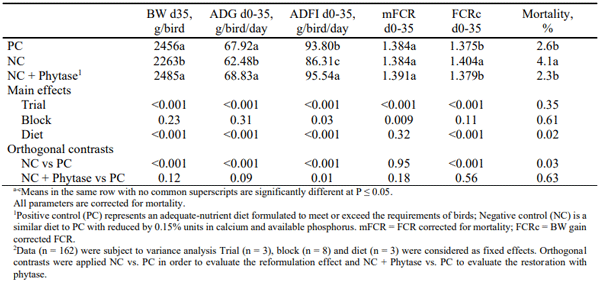Evaluation of a Novel Bacterial 6-Phytase on Growth Efficiency of Broilers at 35 Days of Age
Three broiler performance studies were conducted in three different facilities to investigate the efficacy of a novel bacterial 6-phytase on growth performance of broilers fed diets deficient in available phosphorus (avP) and total calcium (Ca). Design was the same for all studies, with three treatments: positive control (PC) diet formulated to meet or exceed the requirements of birds, negative control (NC) diet reduced by 0.15% units in avP and Ca, and the NC diet supplemented with phytase (NC + Phytase) at 500 FTU/kg diet from one to 35 days of age. Body weight (BW) and feed intake were measured at 21 and 35 days of age, and average daily gain (ADG), average daily feed intake (ADFI), feed conversion ratio (FCR), body weight gain corrected FCR (FCRc) and mortality were calculated for the experimental period. The P and Ca deficiency in the NC diet resulted in a lower (P <0.001) final BW (-7.9%), ADFI ( -8.0%) and ADG (-8.0%) leading to a higher FCRc (+2.2%, P <0.001) and mortality (+1.6% unit, P = 0.03) compared with the PC diet. The supplementation of NC diet with phytase improved (P <0.001) the final BW (+9.9%), ADG (+10.2%), ADFI (+10.7%) and FCRc (-1.8%). Phytase addition also decreased (P = 0.02) the percentage of mortality by 1.9% unit in comparison to NC diet. These performance parameters were similar to those of birds fed adequate-nutrient PC diet except for ADFI which is higher (+1.9%, P=0.03) in diet supplemented with phytase. Thus, avP and Ca can be lowered similarly by 0.15% units from bacterial phytasesupplemented diets without effects on growth performance of broilers.
I. Introduction
II. Method
III. Results and discussion

Amerah AM, Plumstead PW, Barnard LP & Kumar A (2014) Poultry Science 93: 906-915.
Aureli R, Ueberschlag Q, Klein F, Noël C, & Guggenbuhl P (2017) Poultry Science 96: 160- 168.
Dersjant-Li Y, Archer G, Stiewert AM, Brown AA, Sobotik EB, Jasek A, Marchal L, Bello A, Sorg RA, Christensen T, Kim H-S, Mejldal R, Nikolaev I, Pricelius S, Haaning S, Sørensen JF, de Kreij A & Sewalt V (2020) Animal Feed Science and Technology 264: 114481.
Dersjant-Li Y, Awati A, Schulze H & Partridge G (2015) Journal of the Science of Food and Agriculture 95: 878e96.
Jlali M, Cozannet P, Moore D & Preynat A (2021) Animal Feed Science and Technology 276: 114927.
Li X, Zhang D, Yang TY, & Bryden WL (2016) Agriculture. 25: 1-15.
NRC (1994) Ninth Revised Edition, National Academy Press, Washington D.C.
Proszkowiec-Weglarz M & Angel R (2013) Journal of Applied Poultry Research 22: 609-627.
Scholey DV, Morgan NK, Riemensperger A, Hardy R & Burton EJ (2018) Poultry Science 97: 2435-2440.
Underwood EJ & Suttle (1999) 3rd edition. Wallingford UK.
Vieira SL, Anschau DL, Stefanello C, Serafini NC, Kindlein L, Cowieson AJ & Sorbara JOB (2015) Journal of Applied Poultry Research 24: 335-342.
Waldroup PW (1999) Poultry Science 78: 683-691.
Woyengo TA & Nyachoti CM (2013) Canadian Journal of Animal Science 93: 9-21.
Of course, this article is interesting and the presented protocol is beyond doubt. However, the authors do not describe the specifics (differences) of the tested phytase from many other 6-phytases studied earlier. This excludes the possibility of explaining why a positive effect was obtained
Prof. V.S Kryukov












.jpg&w=3840&q=75)